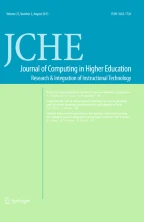Abstract
THIS ARTICLE describes seven examples of a teaching method for introductory computer science which is based on visualization and the use of extensive bodies of sample software. The aim is to use visualization as the means for integrating the other activities a student must do: reading algorithm and data structure descriptions, studying code from model programs and toolkits, designing software components, and building or enhancing programs. The method is strongly laboratory-based because we believe that students must be actively engaged to learn well. By the use of shell programs, the laboratory projects are carefully designed to focus student energy on the critical issues rather than on mundane details.
Similar content being viewed by others
Explore related subjects
Discover the latest articles, news and stories from top researchers in related subjects.References
Abernethy, K., & Allen, Jr., J.T. (1992).Experiments in computing: Laboratories for introductory computer science in THINK Pascal™.Brooks/Cole.
Augenstein, M. &Yedidyah, L. (1988).Automatic generation of graphic displays of data structures through a preprocessor,SIGCSE Bulletin. February,20,148.
Baecker, R.M. & Sherman, D. (1981).Sorting out sorting, 16mm color sound film, 30 minutes.(Shown at ACM SIGGRAPH ’81 in Dallas, TX and excerpted in ACM SIGGRAPH Video Review No. 7, 1983.)
Brown, C., Fell, H.J., Proulx, V.K., & Rasala, R. (in press). Programming by experimentation and examples.Proceedings of the 4th ICCAL at Acadia, Nova Scotia, Springer Verlag.
Brown, M.H. (1988). Perspectives on algorithm animation.Proceedings of the ACM SIGCHI ’88 Conference on Human Factors in Computing Systems,(pp. 33–44).
Brown, M.H. &Sedgewick, R. (1985, January). Techniques for algorithm animation.IEEE Software, 22(1),28–39.
Gardner, M. (1970, October).Mathematical games: The fantastic combinations of John Conway’s new solitaire game “Life”.Scientific American, 223(10),120–123.
Gardner, M. (1971, February).Mathematical games: On cellular automata, self-reproduction, the garden of eden and the game “Life”.Scientific American, 224(2),112–117.
Lammers, S. (1986).Programmers at work. Microsoft Press.
Linn, M.C. &Clancy, M.J. (1992, March).The case for case studies of programming problems.Communications of the ACM,35(3),121–132.
Naps, T.L. (1990, February).Algorithm visualizaiton in computer science laboratories.SIGCSE Bulletin,221(1),105–110.
Reiss, S.P. (1985, March).PECAN: Program development systems that support multiple views.IEEE Software, SE-11(3),276–285.
Robergé, J. (1992, March),Creating programming projects with visual impact.SIGCSE Bulletin.24(1),230–234.
Stasko, J.T. (1990, September).Tango: A framework and system for algorithm animation.IEEE Computer, 23(9),27–39.
Tucker, A.B. (1992).Fundamentals of computing I: Logic, problem solving. Programs & Computers,New York:McGraw Hill.
Tucker, A.B., Barnes, B.H., Aiken, R.M., Barker, K., Bruce, K.B., Cain, J.T., Conry, S.E., Engel, G.L., Epstein, R.G., Lidtke, D.K., Mulder, M.C., Rogers, J.B., Spafford, E.H., & Turner, A.J. (1991). Computing curricula 1991. (Report of the ACM/IEEE-CS Joint Curriculum Task Force). ACM Press.
Author information
Authors and Affiliations
Additional information
ABOUT THE AUTHORS
Cynthia Brown received her Ph.D. degree in Mathematics in 1977 from the University of Michigan. She has held positions at Indiana University and GTE Laboratories, and is currently Dean of the College of Computer Science at Northeastern University. Her professional interests include algorithms (especially backtracking), expert systems, and computer science education. She is a member of IEEE, AAAI, and ACM.
Harriet Fell is a Professor of Computer Science at Northeastern University in Boston. She received a Ph.D. in Mathematics from M.I.T. in 1969. Her interests, in addition to computer science education, include cryptography and the development of software for severely disabled individuals. She received the Goodwin medal for excellence in teaching at M.I.T. in 1969 and the Northeastern University excellence in teaching award in 1987. This year, she received an award of merit in the Johns Hopkins National Search for Computing to Assist Persons with Disabilities. She is a member of ACM.
Viera Krnanová Proulx is Associate Professor at the College of Computer Science at Northeastern University in Boston. She received a Ph.D. in Computing Science from Columbia University in 1977 for her work on classifying toroidal groups. She is a member of the Precollege Committee of the Education Board of the ACM that is currently working on designing a new high school curriculum in computer science. Her interests in addition to computer science education include graph theory, parallel processing and architectures, and interconnection networks. She is a member of IEEE, AMS, and ACM.
Richard Rasala is a Professor of Computer Science and Director of Undergraduate Studies in the College of Computer Science at Northeastern University. He received a Ph.D. in Mathematics from Harvard University in 1969. His interests in computation began with numerical approximations in the early 1960’s. During the 1970’s, he was interested in numerical methods for linear algebra and utilized computation in group theory. During the 1980’s, he moved to the College of Computer Science and became interested in the application of computer graphics and software design principles to computer science education. He is a member of IEEE and ACM.
Rights and permissions
About this article
Cite this article
Brown, C., Fell, H., Proulx, V.K. et al. Using visual feedback and model programs in introductory computer science. J. Comput. High. Educ. 4, 3–26 (1992). https://doi.org/10.1007/BF02940977
Issue Date:
DOI: https://doi.org/10.1007/BF02940977
